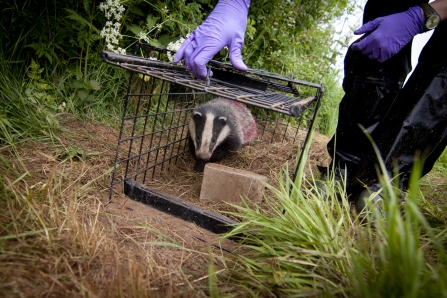
Badger being released after vaccination. © Tom Marshall

Badger being released after vaccination. © Tom Marshall
The first cases of bovine TB in badgers were confirmed in August 2017. Apha officials believe the disease spread into the Low Risk Area (LRA) from cattle brought from Northern Ireland with the disease transmitting to wildlife. Bovine TB was first found in the area, known as the Shap Cluster or Hot Spot 21 (HS21), in November 2014.
Almost 34,083 badgers have been killed since culls began in 2013[1] across the UK. The Wildlife Trusts nationally are concerned that this culling is putting local populations of badgers at risk in affected parts of the British countryside and urge Natural England to publish the information they hold on the impact of the badger cull on the wider environment.*
David Harpley, Cumbria Wildlife Trust’s Conservation Manager says: “We work closely with many farmers across Cumbria and recognise the difficulties they face. No one wants to see cattle herds being devastated by bovine tuberculosis (bTB), but killing badgers will not solve the problem. Badgers are not the primary cause of the spread of bTB in cattle: the primary route of infection is cattle-to-cattle contact[2]. The Government's badger cull is flying in the face of science. It should be putting more resources into speeding up the development of an effective cattle vaccine, amongst other measures.”
In the absence of cattle vaccination, The Wildlife Trusts believe that vaccination of badgers is a more humane and effective solution to helping stop the spread of bTB than culling. A shortage of BCG vaccine put a temporary halt to badger vaccination in 2016 and Defra did not find alternatives. But this year some Wildlife Trusts sourced vaccine independently - these Wildlife Trusts are now re-commencing badger vaccination. The latest figures† show that on average it costs a Wildlife Trust just £82 to vaccinate an animal, as compared to the cull which cost £6,800 per badger between 2012-2014[3].
The Government spent almost £450,000 on communications equipment alone to support the culls between 2016-2017[4]. This money could have been invested in cattle vaccine research or used to vaccinate nearly 5,500 badgers.
The Wildlife Trusts call on the Government to:
Although The Wildlife Trusts don’t agree with the policy of badger culling, if it takes place, robust monitoring programmes should be implemented in all cull zones.
More information about the badger cull is available on The Wildlife Trusts’ website.
The Government ... should be putting more resources into speeding up the development of an effective cattle vaccineDavid HarpleyConservation Manager, Cumbria Wildlife Trust
References:
1These figures are available on the Gov.uk website here: https://www.gov.uk/government/policies/bovine-tuberculosis-bovine-tb
*The Information Commissioner’s Office (ICO) this summer ruled that Natural England must release this information or face the High Court. You can see the Information Commission Office’s decision notice here: https://ico.org.uk/media/action-weve-taken/decision-notices/2017/2014420/fer0659789.pdf
2Carter et al., 2012. BCG Vaccination Reduces Risk of Tuberculosis Infection in Vaccinated Badgers and Unvaccinated Badger Cubs. PLOS One, 7: e49833
†Figures newly compiled from 2015 Wildlife Trust vaccination schemes
3These figures were provided in response to a Freedom of Information (FOI) request, which is available in full on the Gov.uk website. NB: The exact figure is £6785.
4The Government publishes all spending over £25,000 here: https://data.gov.uk/dataset/financial-transactions-data-defra